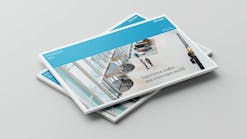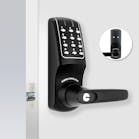School safety is an omnipresent focus, as it should be. More effective procedures and innovative technological solutions to safeguard students and staff from the threat of violence and other dangers continue to be hot topics.
Everything from stronger fences, robust visitor management, and empowered classroom locks to sophisticated video surveillance and digital access control solutions are among the must-haves in today’s schools. Many ideas – some controversial – are all on the table: new weapons detection devices, additional resource officers, and even arming school staff.
School safety and security is vital. New methods, more training, advanced technologies, and greater awareness and vigilance all contribute to more appropriate responses, effective action and successful outcomes. Additional measures to protect school perimeters, hardening entrances, tightening visitor management, and closely monitoring activity all play a part.
As stringent as safety and security measures need to be, schools shouldn’t end up feeling like an oppressive fortress. What’s most important is creating a learning environment that promotes creativity, productivity, and healthy interaction, and builds social skills, critical thinking, pride, and success. In other words, a place where students and staff are at ease and comfortable in their surroundings so they can focus on getting the most out of the education experience.
As a result, architects and district decision-makers are placing greater importance on the materials, finishes, colors, graphics, and other design considerations for schools.
Curb to Core Aesthetics
On outer perimeters of schools, modern fence designs are replacing old chainlink barriers. Along with being much more attractive, their lack of footholds and handholds prevents intruders from scaling them while still allowing a view into the campus grounds to suggest a sense of welcoming and openness.
Security measures such as non-threatening visitor check-in vestibules and facial identification kiosks help balance security, functionality, and aesthetics to project an innovative and more pleasant learning environment.
Even something as fundamental as a classroom interior door lock with a sleek lever, thumb turn, and clearly visible status indicator can be as good-looking as it is reassuring and essential. Lock designs like these are simple to engage, empowering students and staff to ensure rooms are secure. They also provide single-motion egress allowing occupants to exit quickly in an emergency.
School colors, emblems, and mascot graphics are fairly standard for most K-12 and university settings. But they can also be extended to doors, customized door levers and pulls, and graphics for security glass films.
Commercial-grade, prefinished steel doors for classrooms and school entrances come in standard as well as custom colors to match a school’s brand. Metal doors and frames can also be customized with wood grain finishes to make openings feel warmer and more inviting. Many are also STC-rated to minimize sound transmission and include vision panels with the option of attack-resistant School Guard Glass™ to delay intruders from entering.
The Beauty of Glass
Glass, in general, has long been a favorite material of architects and designers for many years. In K-12 and higher education environments, it brings a sense of openness that helps promote well-being and communication. Increased daylighting and visibility connect students to others, nature, and the experiential environment, which can improve learning, behavior, and test scores. However, along with the benefits of glass come concerns about its potential safety and security attributes.
Surveys have found that most K-12 schools, for instance, have not hardened the glass on exterior door vision panels and sidelites, particularly those used at key entrances – an intruder’s most likely first target. Unreinforced glass in those doors and windows can be the weakest link and easily breached.
Installing attack-resistant School Guard Glass is one option for addressing these vulnerabilities. Security window films are also an alternative and likely a lower cost retrofit solution for schools.
In the latest edition of the PASS Safety and Security Guidelines for K-12, the Tier 1 Architectural Component under the Building Perimeter Layer section specifies that “Security window film at least 14 millimeters thick (350 microns) should be installed on all exterior door vision panels and sidelites. Security film serves to deter or delay the ability of an attacker to breach a doorway using a firearm or other tool/weapon, in addition to limiting injuries from glass shards resulting from a blast, fire, accident, natural disaster or severe weather event. This type of solution can be retrofitted within most commercial window systems and incorporated into insulating glass units.”
There are renowned brands of industry tested security film products on the market. Installed and anchored properly on the inside surface of glazing, they can be extremely effective in buying the extra precious minutes needed for law enforcement to respond and students, teachers, and staff to shelter in place. No safety and security film is bullet proof but the higher the product’s tier level rating and tear resistance, the longer it holds and more difficult and discouraging it is to breach a glazed entrance.
One-way, reflective film products installed on lower classroom windows also offer a layer of discouragement by preventing intruders from seeing in while still allowing occupants to clearly see out. Graphics film treatments are another option that blocks the view from outside. They also create an opportunity for aesthetic branding and mottos that project school spirit in a positive way.
Wayfinding colors are another extra touch that’s visually appealing and provides a simple, safe way to guide students to activity and academic areas as well as critical egress points. They can also be used to reinforce school colors or as a box of crayon theme to simply brighten up interiors.
Some schools and institutions might even choose to include customized finishes and embossed textures or school emblems on handles, pulls, and other door hardware to reflect a school’s character and specializations.
As an example, the Yale Peabody Museum of Natural History recently re-opened after a multi-year renovation and expansion. As part of the re-design, Centerbrook Architects & Planners wanted customized door handles and pulls that reflected the essence of the museum – something that would feel organic, weighty, and substantial yet fit a hand naturally and make visitors think “that’s a Peabody door handle.”
Adding extra design features, whether subtle or bolder, can go a long way in creating a more pleasant, intriguing, and enjoyable learning experience while also helping to increase safety as well as privacy.
Chris Gisslen is Director of Business Development - K12, ASSA ABLOY





